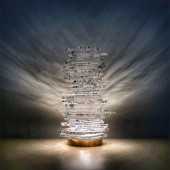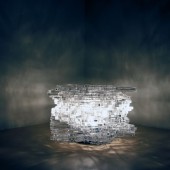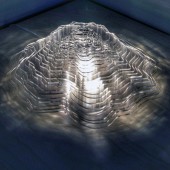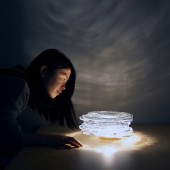
| THE AWARD |
| CATEGORIES |
| REGISTRATION |
| SUBMIT YOUR WORK |
| ENTRY INSTRUCTIONS |
| TERMS & CONDITIONS |
| PUBLICATIONS |
| DATES & FEES |
| METHODOLOGY |
| CONTACT |
| WINNERS |
| PRESS ROOM |
| GET INVOLVED |
| DESIGN PRIZE |
| DESIGN STORE |
| THE AWARD | JURY | CATEGORIES | REGISTRATION | PRESS | WINNERS | PUBLICATIONS | ENTRY INSTRUCTIONS |
Diatom Lights Illumination by YINGRI GUAN |
Home > Winners > Design #83458 >Interview |
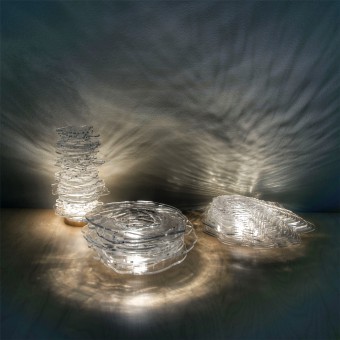 |
|
FS: What is the main principle, idea and inspiration behind your design?
YG: The most challenging aspect of this design is in the process of understanding how the different materials work together. For example, I know that acrylic glass edges catch light really well. Exactly how it would look like with them stacked together I have no idea. Also, the difficulty comes in when it comes to decide what algorithms to use to generate the shapes and forms. How do I achieve the illuminating effect I have in mind. How do I convey the idea of representing a very micro organism in this 3 dimensional world.
FS: What has been your main focus in designing this work? Especially what did you want to achieve?
YG: The most challenging aspect of this design is in the process of understanding how the different materials work together. For example, I know that acrylic glass edges catch light really well. Exactly how it would look like with them stacked together I have no idea. Also, the difficulty comes in when it comes to decide what algorithms to use to generate the shapes and forms. How do I achieve the illuminating effect I have in mind. How do I convey the idea of representing a very micro organism in this 3 dimensional world.
FS: What are your future plans for this award winning design?
YG: The future plan is to expand upon this design and take it to a step above and beyond to see where I can push the boundaries. If opportunities surface, this could land in some people's homes for custom orders.
FS: How long did it take you to design this particular concept?
YG: It took me about two months to design this particular concept with iterations, fine-tuning and testing with technology. The whole project took about six months in total, that's with installation and adjustment.
FS: Why did you design this particular concept? Was this design commissioned or did you decide to pursuit an inspiration?
YG: The most challenging aspect of this design is in the process of understanding how the different materials work together. For example, I know that acrylic glass edges catch light really well. Exactly how it would look like with them stacked together I have no idea. Also, the difficulty comes in when it comes to decide what algorithms to use to generate the shapes and forms. How do I achieve the illuminating effect I have in mind. How do I convey the idea of representing a very micro organism in this 3 dimensional world.
FS: Is your design being produced or used by another company, or do you plan to sell or lease the production rights or do you intent to produce your work yourself?
YG: My design is not used by another company. I plan to produce this work in small quantity myself for now.
FS: What made you design this particular type of work?
YG: The most challenging aspect of this design is in the process of understanding how the different materials work together. For example, I know that acrylic glass edges catch light really well. Exactly how it would look like with them stacked together I have no idea. Also, the difficulty comes in when it comes to decide what algorithms to use to generate the shapes and forms. How do I achieve the illuminating effect I have in mind. How do I convey the idea of representing a very micro organism in this 3 dimensional world.
FS: Where there any other designs and/or designers that helped the influence the design of your work?
YG: The most challenging aspect of this design is in the process of understanding how the different materials work together. For example, I know that acrylic glass edges catch light really well. Exactly how it would look like with them stacked together I have no idea. Also, the difficulty comes in when it comes to decide what algorithms to use to generate the shapes and forms. How do I achieve the illuminating effect I have in mind. How do I convey the idea of representing a very micro organism in this 3 dimensional world.
FS: Who is the target customer for his design?
YG: The most challenging aspect of this design is in the process of understanding how the different materials work together. For example, I know that acrylic glass edges catch light really well. Exactly how it would look like with them stacked together I have no idea. Also, the difficulty comes in when it comes to decide what algorithms to use to generate the shapes and forms. How do I achieve the illuminating effect I have in mind. How do I convey the idea of representing a very micro organism in this 3 dimensional world.
FS: What sets this design apart from other similar or resembling concepts?
YG: The most challenging aspect of this design is in the process of understanding how the different materials work together. For example, I know that acrylic glass edges catch light really well. Exactly how it would look like with them stacked together I have no idea. Also, the difficulty comes in when it comes to decide what algorithms to use to generate the shapes and forms. How do I achieve the illuminating effect I have in mind. How do I convey the idea of representing a very micro organism in this 3 dimensional world.
FS: How did you come up with the name for this design? What does it mean?
YG: This piece is inspired by the phenomenal contributions diatom algae bring to our world. Diatoms are light-absorbing molecules that convert light energy from the sun to chemical energy through photosynthesis. In the process, carbon dioxide is removed from the atmosphere, converted into sugar, and oxygen is released. In addition, diatoms are a major source of food for aquatic life on earth. Therefore, this piece aspires to celebrate diatoms as essential organisms to our whole ecosystem.
FS: Which design tools did you use when you were working on this project?
YG: I used processing to generate the shapes, Adobe Creative Suite to convert different file formats and laser cutter to produce the final physical forms.
FS: What is the most unique aspect of your design?
YG: The most challenging aspect of this design is in the process of understanding how the different materials work together. For example, I know that acrylic glass edges catch light really well. Exactly how it would look like with them stacked together I have no idea. Also, the difficulty comes in when it comes to decide what algorithms to use to generate the shapes and forms. How do I achieve the illuminating effect I have in mind. How do I convey the idea of representing a very micro organism in this 3 dimensional world.
FS: Who did you collaborate with for this design? Did you work with people with technical / specialized skills?
YG: The most challenging aspect of this design is in the process of understanding how the different materials work together. For example, I know that acrylic glass edges catch light really well. Exactly how it would look like with them stacked together I have no idea. Also, the difficulty comes in when it comes to decide what algorithms to use to generate the shapes and forms. How do I achieve the illuminating effect I have in mind. How do I convey the idea of representing a very micro organism in this 3 dimensional world.
FS: What is the role of technology in this particular design?
YG: The most challenging aspect of this design is in the process of understanding how the different materials work together. For example, I know that acrylic glass edges catch light really well. Exactly how it would look like with them stacked together I have no idea. Also, the difficulty comes in when it comes to decide what algorithms to use to generate the shapes and forms. How do I achieve the illuminating effect I have in mind. How do I convey the idea of representing a very micro organism in this 3 dimensional world.
FS: Is your design influenced by data or analytical research in any way? What kind of research did you conduct for making this design?
YG: The most challenging aspect of this design is in the process of understanding how the different materials work together. For example, I know that acrylic glass edges catch light really well. Exactly how it would look like with them stacked together I have no idea. Also, the difficulty comes in when it comes to decide what algorithms to use to generate the shapes and forms. How do I achieve the illuminating effect I have in mind. How do I convey the idea of representing a very micro organism in this 3 dimensional world.
FS: What are some of the challenges you faced during the design/realization of your concept?
YG: The most challenging aspect of this design is in the process of understanding how the different materials work together. For example, I know that acrylic glass edges catch light really well. Exactly how it would look like with them stacked together I have no idea. Also, the difficulty comes in when it comes to decide what algorithms to use to generate the shapes and forms. How do I achieve the illuminating effect I have in mind. How do I convey the idea of representing a very micro organism in this 3 dimensional world.
FS: How did you decide to submit your design to an international design competition?
YG: The most challenging aspect of this design is in the process of understanding how the different materials work together. For example, I know that acrylic glass edges catch light really well. Exactly how it would look like with them stacked together I have no idea. Also, the difficulty comes in when it comes to decide what algorithms to use to generate the shapes and forms. How do I achieve the illuminating effect I have in mind. How do I convey the idea of representing a very micro organism in this 3 dimensional world.
FS: What did you learn or how did you improve yourself during the designing of this work?
YG: The most challenging aspect of this design is in the process of understanding how the different materials work together. For example, I know that acrylic glass edges catch light really well. Exactly how it would look like with them stacked together I have no idea. Also, the difficulty comes in when it comes to decide what algorithms to use to generate the shapes and forms. How do I achieve the illuminating effect I have in mind. How do I convey the idea of representing a very micro organism in this 3 dimensional world.
FS: Any other things you would like to cover that have not been covered in these questions?
YG: The most challenging aspect of this design is in the process of understanding how the different materials work together. For example, I know that acrylic glass edges catch light really well. Exactly how it would look like with them stacked together I have no idea. Also, the difficulty comes in when it comes to decide what algorithms to use to generate the shapes and forms. How do I achieve the illuminating effect I have in mind. How do I convey the idea of representing a very micro organism in this 3 dimensional world.
FS: Thank you for providing us with this opportunity to interview you.
A' Design Award and Competitions grants rights to press members and bloggers to use parts of this interview. This interview is provided as it is; DesignPRWire and A' Design Award and Competitions cannot be held responsible for the answers given by participating designers.
| SOCIAL |
| + Add to Likes / Favorites | Send to My Email | Comment | View Press-Release | Translations |

